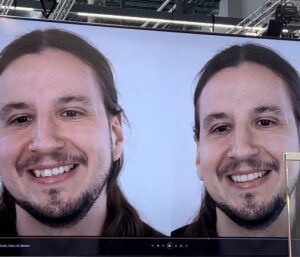Transforming Workflows and Enhancing Patient Acceptance
Artificial intelligence (AI) has become a buzzword in the dental industry, much like “aesthetics,” “intuitiveness,” and “lab quality” have in the past. While some companies use these terms as marketing jargon, AI is truly revolutionizing dentistry, especially in clinical CAD-CAM workflows. Let’s explore how AI is impacting the industry and discuss some exciting developments, including the latest from exocad and other AI-powered tools.
Dentistry evolution
AI in dentistry is no longer a futuristic concept. It is here, shaping various aspects of dental care and production. Companies like Aligntech and exocad are leading the charge with innovative AI-driven solutions that simplify and improve workflows. For instance, exocad’s release of it’s AI platform which dramatically reduced the time to design crowns.
iTero, another Aligntech company, has been using Artificial Intelligence for years in their intraoral scanner. Read this article from way back in 2022! How Aligntech uses AI. It details the several features that were available through the use of AI even all those years ago. You can only just imagine how are we have come now with products such as the Invisalign Outcome Simulator and the methods by which the intraoral scanner captures data.

I expect to see additional features in other exocad CAD modules including Smile Creator.
Read more about exocad Smile Creator here.
We have already seen the live feed feature showing patients how their smile will look as they move, talk, and smile. The live feed aspect brings a new level of interactivity and realism, significantly enhancing patient engagement and acceptance. These type of workflows being further advanced by AI will take Dentistry into the stratosphere.

Many AI-powered systems debuted at IDS two years ago and left audiences, myself included, with goosebumps. In two months, I’ll be there to see many more.
I couldn’t help but reflect on how much more confident I would have been if such technology existed when I managed a large dental lab in Melbourne. Back then, investing in new equipment often felt like a leap of faith—from the first milling machine we purchased to the promises of support that didn’t always materialize. With tools like these, dentists and labs today have a much clearer vision of what they’re getting.
AI and Patient Acceptance Tools
One of the longstanding challenges in dentistry has been improving patient acceptance of proposed treatments. Traditionally, dentists relied on 2D photography systems, diagnostic wax-ups, and even fast 3D-printed shells to give patients a preview of their potential new smile. These tools have been effective, but they often require a leap of faith from patients. Almost instantaneous proposals will make this process simpler for all.
I remember grappling with faith as a kid when my grandma assured me that an all-seeing God was watching my every move—especially when sneaking chocolates or making faces at my brother. That same uneasy reliance on faith has echoed throughout my career, from buying my first car (a Proton Satria, supposedly engineered by Lotus—it wasn’t reliable) to trusting early dental technologies. But with advancements in Artificial intelligence, this leap of faith is becoming smaller.
Tools like exocad Smile Creator, combined with Asiga 3D printers, allow dentists to produce quick and precise printed shells. These can be placed over the patient’s teeth, enabling them to take a tangible preview home.
That same live smile design powered by AI, will eliminate even more barriers. Patients can see dynamic, realistic previews of their smile design in real-time, removing much of the uncertainty from the decision-making process.

CAD-CAM Equipment and Software
As AI continues to evolve, its integration with CAD-CAM equipment and software will redefine how dental practices and labs operate. Brands like imes-icore CORiTEC milling machines are poised to benefit from AI advancements. CAM software is expected to adopt more AI-driven features, such as automated job preparation, which will significantly reduce loading times and streamline workflows. Faster, smarter systems mean increased productivity and more predictable results—a win-win for both dentists and their patients.
AI-Supported Diagnostic Tools
Beyond smile design and patient acceptance, AI is making strides in diagnostics. Advanced AI algorithms can identify early signs of oral health issues, providing dentists with more accurate insights and enabling timely interventions. These tools enhance the quality of care and ensure that patients receive treatments tailored to their specific needs.
The Future of AI in Dentistry
Artificial Intelligence is still in its infancy within the dental field, but the strides being made are remarkable. While early iterations of AI-designed 3D printed models and nightguards had their limitations, the technology is rapidly maturing. As companies refine their algorithms, we can expect more precise designs and seamless integration into everyday workflows.
For example, AI-powered diagnostic tools are helping dentists identify issues that might otherwise go unnoticed. This ensures patients receive timely and accurate care. Similarly, patient acceptance tools are becoming more interactive and personalized, removing much of the guesswork and improving overall satisfaction.
Embracing the Potential
As we look ahead, the integration of AI in dental workflows promises to enhance efficiency, accuracy, and patient trust. We should expect to see more highly engaging AI-assisted Smile Design with live video. This technology can transform the patient experience. Similarly, the incorporation of Artificial Intelligence into CAM software for systems like imes-icore CORiTEC milling machines will pave the way for faster, more reliable production processes.
In the words of George Michael, “you gotta have faith.” But with the advancements in AI, perhaps you and your patients won’t need to rely on faith alone anymore.
